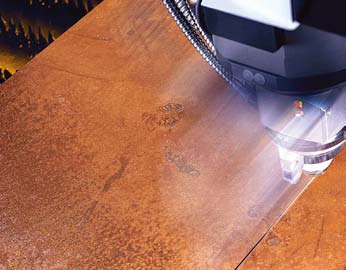
The company is well ahead of the curve when it comes to investing in digitally connected, autonomous factories. This new feature, Active Speed Control, looks straight through the nozzle right at the cutting zone, monitoring it in real-time and autonomously controlling the feed rate of solid-state laser machines. This new function ensures a more reliable process for both flame and fusion cutting, reducing scrap and saving on rework.
Active Speed Control also responds immediately to any changes in the material being processed. The system allows users to achieve tangible gains in productivity with their machines, significantly lowering part manufacturing costs. It monitors numerous different process parameters. One example is the position of the laser beam in relation to the center of the nozzle during the entire cutting process. The system informs the operator of any deviations, helping to avoid scrap. Additional functions for automated laser cutting can easily be added to the system in the future thanks to the software update feature.
Maximum speed even with variations in material thicknesses
The kerf reveals all sorts of information about part quality and process stability. The easier it is for the molten material to escape from the kerf, the smoother the cutting process. Active Speed Control keeps a careful eye on this flow of molten material in mild and stainless steel plates that are four or more millimeters thick. The sensor system looks straight through the nozzle to observe the radiation that is emitted as the material melts. This “process radiation” allows the system to determine whether the molten material is emerging as planned, to identify the fastest possible feed rate, and to make any necessary adjustments – a process it repeats many hundreds of times a second.
In this way, the system maintains the optimum feed rate even in cases where the thickness of the material varies within a single sheet, or where the top of the sheet is contaminated with rust or paint. In conventional systems, these kinds of variations and changes in material would typically lead to slag formation or interruptions in the cutting process.
Smart sensor system makes life easier for machine operators
Currently, machine operators have to tailor the feed rate – a critical parameter – to the material they are cutting, and adjust it as necessary. One way they do this is by making test cuts. Active Speed Control eliminates the need for these kinds of tests. That simplifies the production process, particularly in single part manufacturing.
To allow for variations in the material, operators also frequently reduce the machine’s feed rate. That makes the process more reliable in many cases, but it often has a negative impact on the cutting process and the quality of the cut. For example, a lower feed rate can cause heat to accumulate within the material. This build-up of heat can cause the material to melt in an uncontrolled fashion, reducing the reliability of the machining process. By automatically controlling the feed rate, the control system prevents this accumulation of heat from developing in the first place.
This feature also offers plenty of other benefits. For example, the operator can view a live image of the cutting zone as seen through the nozzle, and they can browse key process parameters at any time on the machine’s control panel or on a tablet. That makes it easier to monitor the machine during production. Previously, operators had to manually create what is known in the industry as a “tapeshot” to ensure that the parameters were set to their optimum values – and that was a laborious and time-consuming process.
Speeds well above the norm
Cutting data tells the machine how to process material of a certain thickness. The calculation of this data includes a buffer to compensate for any variations in the composition of the sheet and to allow for less experienced operators who may not have configured the machine optimally for the next job. Ultimately, this means the machine is cutting at a lower feed rate than it is capable of. Active Speed Control eliminates the need for this buffer. The sensor system allows the machine to always work as fast as it can while maintaining the required levels of process reliability. In many cases, Active Speed Control even achieves speeds that are significantly higher than the default values specified in the cutting data.
Improving part quality while reducing part costs
Parts that have not been completely cut from the skeleton or that feature a lot of slag lead to higher scrap rates and wasted time – especially if the cutting problems occur during a night shift. But with automatic feed control, this hardly ever happens. In the event of a miscut, Active Speed Control brings the machine to a halt, and the TruTops Monitor software immediately notifies the operator that they need to take action. Active Speed Control also reduces burr and slag formation.
Innovation for autonomous laser cutting
TRUMPF 2D laser cutting machines feature numerous different assistance systems that help operators cut parts in a reliable fashion. One example is Smart Collision Prevention, which is programmed to take tilting parts into account and then develops a processing strategy in its calculations to avoid collisions with the cutting head. Meanwhile, the Drop&Cut assistance system makes it easier than ever to produce additional parts from scrap skeletons. As well as providing assistance, TRUMPF machines also feature an increasing proportion of functions that control processes autonomously. One example is Smart Nozzle Automation, a function that periodically inspects the nozzle and automatically replaces it if it is damaged. The TruLaser Center 7030 runs all its processes in a completely automated fashion, from programming to part sorting. Active Speed Control is yet another example of TRUMPF’s ongoing mission to create innovations on the path toward autonomous laser cutting.
Nike Ambassador VIII 8













